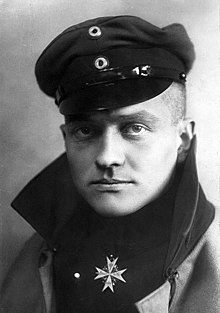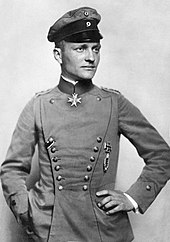This Day in History April 21st Part II Death of the Red Barron
Over the European skies of World War I he reigned supreme. In his distinctive red Fokker triplane Manfred Von Richthofen was both feared and respected for his air combat genius. However, on April 21st of 1918 the "Red Barron" as he was widely known, met his fate at the hands of the allies. Considered the most brilliant combat pilot of World War I and one of the most revered fighter pilots in the world, Manfred von Richthofen left his mark on the pages of aviation history.

In the beginning
Born in Prussia, then part of the German Empire, Manfred served in the cavalry in 1914, at the beginning of WWI, but signed up for the German air force in 1915. There he quickly demonstrated the air to air skills that would make him a legend in his nation of Germany and a much respected foe by his allied enemies. One must remember that in World War I all fundamental air combat tactics were invented and refined. What those World War I pioneers of the skies achieved form, even now, the very Bible of air combat maneuvers from the "Split S" to the "Barrel Roll". Today's fighter pilots are trained in these tactics today at places like Miramar, San Diego at the US Navy TOP GUN fighter tactics school to the Naval Strike and Air Warfare Center at Fallon Naval Air Station in Nevada.
Death in the skies
The inventiveness of the first generation of combat aviators and their aircraft devised tactics taught extensively to military pilots all over the world today. These air warriors of WWI were the galant aerial knights in shining armor using a mixture of bravery and deadly skills that left their foes in burning wreckage on the battlefields of Europe at a time when there were no parachutes as part of their survival gear. Manfred Von Richthofen flourished in this hostile environment taking on 2 or 3 allied fighters at a time and more often than not leaving a trail of crashed and burning Spads, Sopwith Camels, or Nieuports in scorched craters behind enemy lines. The Red Barron also trained future pilots who would soon be flying alongside him.
Record kills
Von Richthofen recieved every concievable medal for his air to air wins numbering 80 allied victories along with 20 probables that could not be verified deep behind enemy lines. He did not even recieve credit for his first 2 kills, one was a French opponent and the other a British flyer. The top scoring ace by far of all pilots allied and German, Manfred was the scourge of the skies. His distinctive red tri-plane would long be rememebered in the decades that followed the war by many enthusiasts and history buffs. Countless books have been written about Richthofen's exploits including a famous movie inspired by the Red Barron, "The Blue Max" starring George Peppard as a talented and ruthless German fighter pilot.

The true thoughts of the man
When asked why he risked his life flying so many missions Richthofen replied that he did it for the fighting men in the trenches. Manfred was known for treating fellow officers, his superiors, and even low ranking non-commissioned personnel with respect as well for the aviation mechanics whom he encouraged his fellow flyers to show appreciation to. The Red Barron did not revel in the propaganda for war time promotion telling people that the number of his aerial victories were exaggerated by the media and that the supposed thrill and glory of battle was actually intense and often grim. Von Richthofen took great effort in training his flying candidates to survive battle and to practice their air to air acrobatics in order to make it back to friendly territory and fight another day.

Deadly technique
Being an ambitious cavalry officer at the beginning of the war, Manfred Von Richthofen became bored with his duties and made great efforts to enter into the aerial combat arena. His first attempts ended in near accidents but he eventually became not only a seasoned pilot with incedible gunnery acumen but, as well, a great squadron leader who inspired his men with his awesome number of air to air victories. Though not as good an acrobatic flyer as some of his contemporaries Von Richthofen's classic tactic of attaining superior altitude, approaching from the rear, and attacking from out of the sun guaranteed the vast number of shoot downs that earned him his reputation.

Death awaits
21st of April 1918 Manfred Von Richthofen met his demise. it all happened as he observed his cousin Wolfram von Richthofen being attacked by a Canadian pilot flying a Sopwith Camel. Manfred fired at Wilfred May forcing the novice pilot to break off his pursuit of Wolfram von Richthofen and the Red Barron began a chase on the tail of the Canadian flyer. However, a friend of the Canadian pilot, Captain Arthur "Roy" Brown saw his buddy in trouble and made a steep dive in an effort to disrupt the air attack to save Wilfred from the Red Barron's guns as he moved in for the kill. Captain Brown nearly crashed only regaing control of his Sopwith Camel seconds before he hit the ground. The Red Barron merely made a turn to avoid the Canadian Captain and Manfred continued to stalk his prey.
The final act
It was at this time that a single .303 bullet found the chest of Rittmeister Manfred Von Richthofen causing a mortal wound that had torn through his lungs and heart. Medical experts agree that it would only take a minute for the fatal injury to cause the Red Barron's death, his iconic Fokker Dr.I 425/17 went down in a steep dive that caused a heavy bounce on the landing gear and crushed the gas tank. As soon as the aircraft rolled to a halt on the ground Canadian military personnel rushed to the cockpit to find Manfred Von Richthofen dead at the controls with his face smashed against the handles of his machine guns.
Against better judgment
Several anti-aircraft units were in action that afternoon along with the allied fighters who had attempted to shoot down the Red Barron. A number of people were incorrecly credited with firing the round that killed Richthofen including Canadian pilot Arthur "Roy"Brown, but AA Gunnery Sergeant, Cedric Popkin, of the Australian 24th Machine Gun Company was credited with hitting Von Richthofen from the side as he flew by. As it turned out the Red Barron was breaking his own strict rules of engagement by flying low over an anti-aircraft defended area at a speed calculated to be 120 mph.
The omen
Medical experts feel that due to severe head wounds that Richthofen suffered to the cranium during a "dog fight" in 1917 in which a machine gun bullet struck him in the head causing temporary blindness and disorientation. Amazingly, the Red Barron managed to emergency land his aircraft in friendly territory. A number of surgeries followed to remove splinters of skull fragments. He was unable to fly for weeks but against doctor's orders, Von Richthofen began combat flying again. Modern day analysis of the old medical records led one team of Texas surgical experts to believe that Manfred suffered permanent brain damage and resulting bad judgment that caused him to make the fatal decision to fly low into heavily AA guarded air space in pursuit of Canadian pilot, Wilfred May. Von Richthofen had complained of headaches and nausea after each combat mission after his brush with near death in 1917.
Doomed author
Among his accomplishments Manfred von Richthofen wrote two autobiographies that were both edited by the German Army propaganda agency that added a number of suspect claims to further the legacy of the Red Barron stating that the British had put a bounty on Richthofen and that they had formed a number of squadrons solely dedicated to downing the magnificent German aviator. Manfred von Richthofen was vehemently displeased with his 2nd book saying that it had been heavily editied and made him appear insolent. The Red Barron never lived long enough to see that edition published before his death. His Fokker aircraft was almost immediately dismantled for trophy as allied soldiers all anxiously wanted a piece of the wreckage.

Finality of a document
The Red Barron had been flying over Morlancourt Ridge near the Somme River when he was shot down landing on a hill near Ray-Corbie Road. His legacy of air to air victories were painstakingly verified through records and testimony. Historians searched memoirs of commanding officers who would have known and witnessed the daring expoits of Manfred von Richthofen, but in all this, his actual certificate of death document was not located until 2009 misspelled as Richthoven with the description as being simply registered in hand written form that he died in April 21, 1918 of wounds sustained during combat. His death certificate was recovered at Ostrów Wielkopolski, Poland.
"Destroying the New World Order"
THANK YOU FOR SUPPORTING THE SITE!
Latest Activity
- Top News
- ·
- Everything
Shadows in the Wind
Mossad: we create a pretend world, we are a global production company... the world is our stage
The Alvin II Encounter: Was There A Living Dinosaur Involved?
All In The Family | Mike Meets Archie For The First Time | The Norman Lear Effect
entitlement
Death Threats for Assisting ICE?
'They’re Waiting for Us to Die': Area 51 Veterans Plead for Trump’s Help | Elizabeth Vargas Reports
© 2025 Created by truth.
Powered by
![]()

You need to be a member of 12160 Social Network to add comments!
Join 12160 Social Network